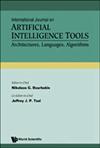WPEviRC: A Multi-rules-based Classifier for Evidential Databases Without Class Label Ambiguities
IF 1
4区 计算机科学
Q4 COMPUTER SCIENCE, ARTIFICIAL INTELLIGENCE
International Journal on Artificial Intelligence Tools
Pub Date : 2022-11-01
DOI:10.1142/s0218213022600028
引用次数: 0
Abstract
Rule-based classifiers use a collection of high-quality rules to classify new data instances. They can be categorized according to the adopted classification strategy: Classifiers based on a single rule, and classifiers based on multiple rules. Many works were proposed in this field. However, most of them do not handle imperfect data. In this study, we focus on the issue of multi-rules-based classification for evidential data, i.e., data where imperfection is modeled via the belief functions theory. In this respect, we introduce a new algorithm called PWEviRC. This latter involves a two-level pruning technique to remove redundant and noisy rules. Finally, it applies the Dempster rule of combination to fuse the selected rules and make the final decision. To evaluate the proposed method, we carried out extensive experiments on several benchmark data sets. The performance study showed interesting results in comparison to existing methods.WPEviRC:一种基于多规则的无类标签歧义的证据数据库分类器
基于规则的分类器使用一组高质量的规则对新数据实例进行分类。可以根据采用的分类策略对它们进行分类:基于单个规则的分类器和基于多个规则的分类器。在这个领域提出了许多工作。然而,它们中的大多数并不处理不完美数据。在本研究中,我们重点研究基于多规则的证据数据分类问题,即通过信念函数理论对不完善数据进行建模的数据。在这方面,我们引入了一种新的算法PWEviRC。后者涉及两级修剪技术,以去除冗余和噪声规则。最后运用Dempster组合规则对所选规则进行融合,做出最终决策。为了评估所提出的方法,我们在几个基准数据集上进行了广泛的实验。与现有方法相比,性能研究显示出有趣的结果。
本文章由计算机程序翻译,如有差异,请以英文原文为准。
求助全文
约1分钟内获得全文
求助全文
来源期刊

International Journal on Artificial Intelligence Tools
工程技术-计算机:跨学科应用
CiteScore
2.10
自引率
9.10%
发文量
66
审稿时长
8.5 months
期刊介绍:
The International Journal on Artificial Intelligence Tools (IJAIT) provides an interdisciplinary forum in which AI scientists and professionals can share their research results and report new advances on AI tools or tools that use AI. Tools refer to architectures, languages or algorithms, which constitute the means connecting theory with applications. So, IJAIT is a medium for promoting general and/or special purpose tools, which are very important for the evolution of science and manipulation of knowledge. IJAIT can also be used as a test ground for new AI tools.
Topics covered by IJAIT include but are not limited to: AI in Bioinformatics, AI for Service Engineering, AI for Software Engineering, AI for Ubiquitous Computing, AI for Web Intelligence Applications, AI Parallel Processing Tools (hardware/software), AI Programming Languages, AI Tools for CAD and VLSI Analysis/Design/Testing, AI Tools for Computer Vision and Speech Understanding, AI Tools for Multimedia, Cognitive Informatics, Data Mining and Machine Learning Tools, Heuristic and AI Planning Strategies and Tools, Image Understanding, Integrated/Hybrid AI Approaches, Intelligent System Architectures, Knowledge-Based/Expert Systems, Knowledge Management and Processing Tools, Knowledge Representation Languages, Natural Language Understanding, Neural Networks for AI, Object-Oriented Programming for AI, Reasoning and Evolution of Knowledge Bases, Self-Healing and Autonomous Systems, and Software Engineering for AI.
 求助内容:
求助内容: 应助结果提醒方式:
应助结果提醒方式:


